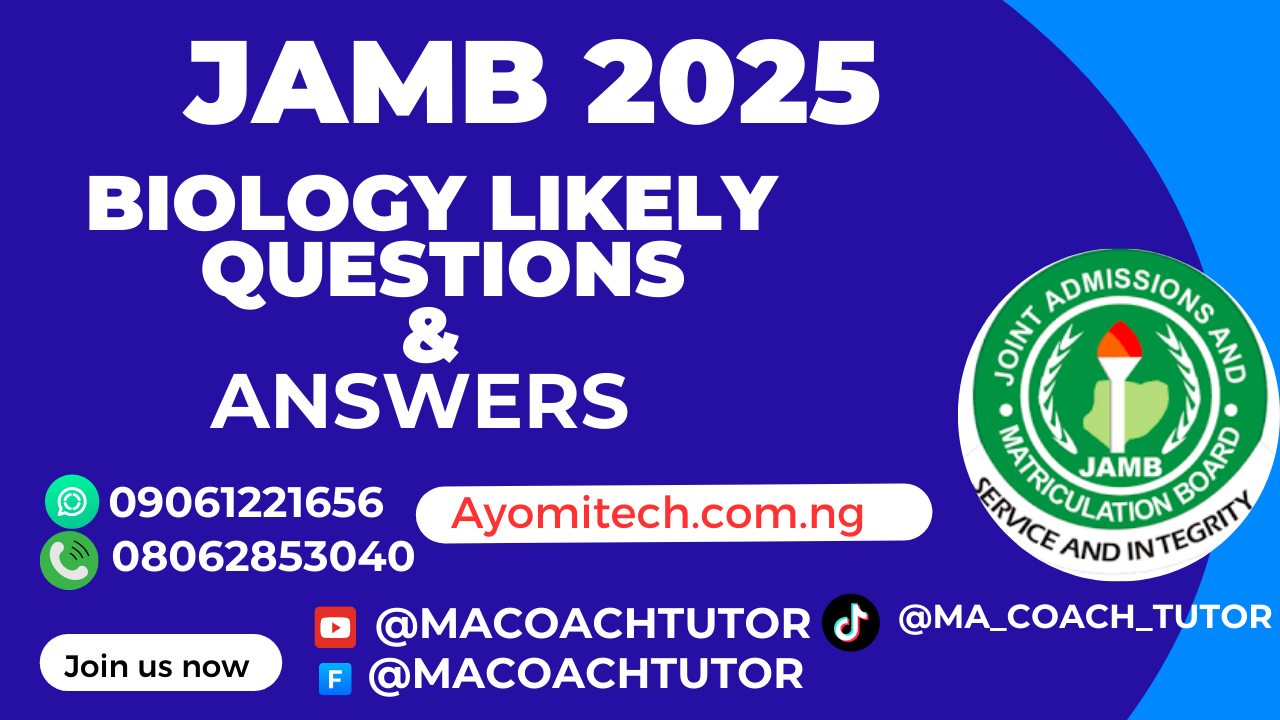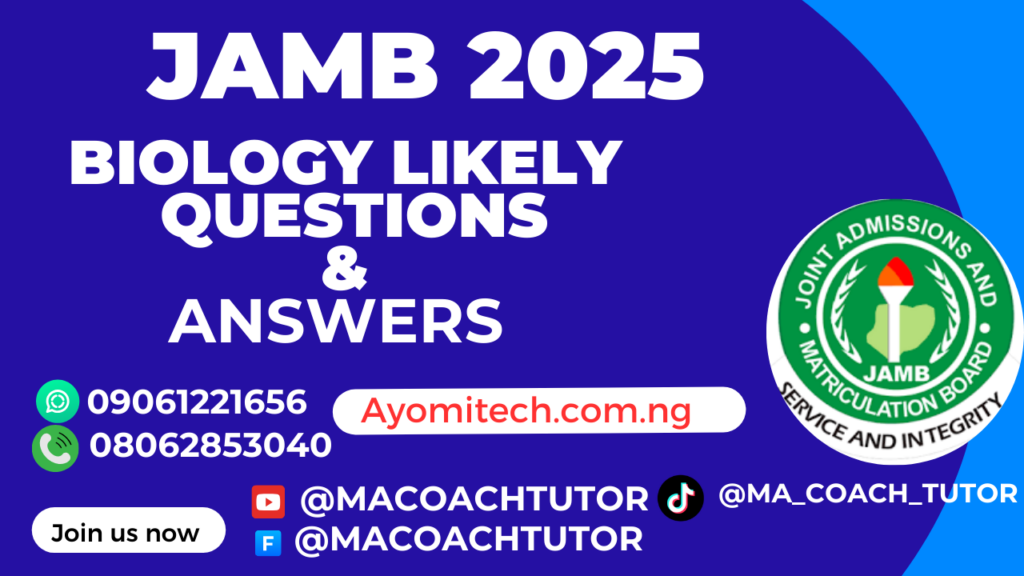JAMB 2025 Biology: 20+ Likely Exam Questions & How to Ace Them

Introduction:
Success in the JAMB 2025 Biology exam requires students to focus on important subjects while practicing common exam questions. The following guide exposes forty or more expected biology questions that will appear in the JAMB 2025 examination while providing knowledgeable advice on effective answering strategies. Continue with me as we enhance your possibility of achieving high results.
Understanding the JAMB 2025 Biology Syllabus
A thorough knowledge of the JAMB 2025 Biology syllabus requires priority before starting to address most probable questions. Cell biology together with genetics combines with ecology and evolution as well as physiology represents the primary subject matters for study.
Study the JAMB-emphasized subject areas specifically to make your preparation more efficient.

20+ Likely JAMB 2025 Biology Questions
Topic: Living Organisms
1. Which of the following cell constituents is
NOT common in both plants and
animals?A. Mitochondria. B. Chloroplasts.
C. Ribosomes. D. Golgi apparatus. E.
Vacuoles.
2. A group of similar cells performing the
same function is A. an organ B. a system C.
a tissue D. an organelle E. an enzyme.
Answer
C- A collection of similar cells
performing the same function is known as
a tissue. Tissues will combine to give an
organ while organs will combine to give a
system.
Topic: Evolutionary Trend
3. In which of the following groups of
animals are flagella and cilia found? A.
Flatwornms B. Annelids C. Coelenterates.
D. Protozoa. E. Nematodes.
Answer
D – Flagella, cilia and pseudopodia are
locomotory structures of protozoans.
4. Which of the following is seed bearing?A.
Mosses. B. Whistling pineC. Algal
filaments D. Liverwort. E. Fern fronds.
Answer
B- Spermatophytes are seed-bearing
plants. Whistling pines are gymnosperms.
Recall that spermatophytes are divided
into angiosperms and gymnosperms.
Topic: structural/ behavioral adaptation of vertebrates
5. In fish the sense organs which detect
movement of the water are located within
the A. gills B. Operculum C. nostrilsD.
median fins E. lateral line.
Answer
E- In fish, the sense organs which detect
movement of the water are located within
the lateral line.
6. Taenia solium can be found in:
(a) pig
(b) cow
(c) goat
(d) dog
Answer
A. Taenia solium inhabits pigs, while Taenia saginata inhabits cows
7. Proboscis is a structure that is mostly found in:
(a) mollusks
(b) amphibians
(c) insects
(d) reptiles
Answer
C. The proboscis of insects is a long, tubular mouthpart used for feeding (e.g., sucking nectar, piercing, and blood-sucking).
8. Which of the following is an adaptation for water conservation?
(a) Prominent stomata in leaves
(b) Spiny leaves
(c) Spongy mesophyll
(d) Broad leaves
Answer
B. The larger the surface area of leaves, the higher the transpiration and water loss.
Spiny leaves reduce water loss, while broad leaves increase it.
9. The digestive enzyme that is present in saliva is:
(a) Renin
(b) Ptyalin
(c) Chymotrypsin
(d) Pepsin
Answer
B. The enzyme ptyalin in saliva breaks down starch into maltose.
10. Plants that have special structures for trapping and digesting insects are:
(a) Saprophytic
(b) Carnivorous
(c) Parasitic
(d) Symbiotic
Answer
Insectivorous plants (e.g., Venus flytrap, Pitcher plants, Sundews) trap and digest insects for nutrition.
11. Which of the following is a waste product of an insect?
(a) Uric acid
(b) Mucilage
(c) Alkaloids
(d) Sweat
Answer
A. Insects excrete uric acid, unlike mammals which excrete urea.
12. The sensory cell that responds to dim light is called:
(a) Cone
(b) Rod
(c) Pupil
(d) Iris
Answer
B. Rod cells function in dim light, while cone cells detect colors.
13. The opening of the guard cells of the epidermis in plants is by the process of:
(a) Diffusion
(b) Osmosis
(c) Active transport
(d) Transpiration
Answer
D. Guard cells control stomatal opening and closing, regulating transpiration.
14. The correct arrangement of food classes of the same quantity in descending order of magnitude of energy values in animals is:
(a) Protein, fats and oils, water and carbohydrates
(b) Carbohydrates, fats and oils, water and protein
(c) Fats and oils, carbohydrates, protein and water
(d) Water, fats and oils, carbohydrates and protein
Answer
C. Fats and oils contain the most energy, followed by carbohydrates, proteins, and then water.
15. Which of the following substances is not a complex carbohydrate?
(a) Starch
(b) Glucose
(c) Cellulose
(d) Glycogen
Answer
B. Complex carbohydrates consist of long-chain molecules (e.g., starch, glycogen, cellulose).
16. The bacteria that convert soil nitrate into atmospheric nitrogen are called:
(a) Nitrifying bacteria
(b) Denitrifying bacteria
(c) Putrefying bacteria
(d) Saprophytic bacteria
Answer
B. Bacteria that convert soil nitrate into atmospheric nitrogen are called denitrifying bacteria (e.g., Pseudomonas denitrificans).
17. The main reason for immunizing children is to:
(a) Stimulate the production of blood
(b) Stimulate the production of antibodies
(c) Increase the production of white blood cells
(d) Destroy pathogens in their bodies
Answer
B. Immunization protects individuals by stimulating the production of specific antibodies against pathogenic antigens. Antibodies are proteins produced by the immune system in response to antigens
18. How do we justify the absence of the 17. digestive system in tapeworms?
(a) It does not feed
(b) It is too small
(c) Its body absorbs digested food
(d) It has no enzymes
Answer
C. Tapeworms do not possess a digestive system because their bodies absorb already digested food.
19. If a blood test shows that a father has blood type O and the mother has blood type A, what is the likely blood type of their child?
(a) AB
(b) AO
(c) BB
(d) AA
Answer
B. Blood type inheritance:
. For a child to have type O, both parents must have the allele combinations AO and AO, BO and BO, AO and BO, or O and O.
A mother with blood type A can have a child with blood type O if her genotype is AO.
20. The network of blood capillaries in the kidney capsule is referred to as:
(a) Capsule
(b) Glomerulus
(c) Pelvis
(d) Pyramid
Answer
B. The glomerulus is a network of tiny blood capillaries in the kidney.
It plays a crucial role in filtration of blood to form urine (glomerular filtration).
Also Read:JAMB 2025 UTME Timetable – Check Your Exam Date & Batch
Call to Action:

Join our free 2025 Jamb & WAEC class
Join the Whatsapp channel below
How to Ace These Questions:
Study every topic mentioned in the syllabus until you have mastered all information.
To understand the format of the examination students need to practice past questions.
The interpretation of challenging concepts becomes simpler through the effective use of diagrams as well as charts.
Group study activities between peers help solidify educational content better.
You should obtain biology news from trusted information sources.
Tips for Effective JAMB Biology Preparation
You need to manage your time by designing a study plan along with consistent execution of it.
Rephrase this sentence. Regular practice tests will help maintain your understanding.
It is perfectly acceptable to approach your teachers or peers whenever you require explanations for subjects you need clarification about.
The key to health success involves obtaining proper rest and consuming wholesome diet.
Conclusion:
Your success in the JAMB 2025 Biology exam will improve when you know the syllabus well combined with practice of probable questions along with strategic study approaches. Focus continuously together with determination will position you in excellent stead to pass the exam.
The guide needs sharing to friends and JAMB tip subscriptions present additional opportunities for learning.
